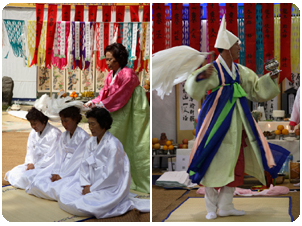Intangible Cultural Heritage of Humanity
Intangible Cultural Heritage of Humanity- Republic of Korea
-
Jeju Chilmeoridang Yeongdeunggut
Yeongdeung Rites for the Goddess of Wind
Jeju Islanders Pray for Plentiful Sea CatchIt is nearly impossible to discuss Korean culture without mentioning the shamanic rituals called gut. Even in modern times, any attempt to have a genuine understanding of Koreans and their culture requires some amount of knowledge about the age-old shamanic tradition, which involves the “disentangling” of knots, or conflicts; the knots between humans and nature, the knots between people, and the knots that exist within our inner selves. It aims to 
help people reconnect with their true nature and inner vitality.
The Jeju Rites for the Goddess of the Wind (Jeju chilmeori yeongdeunggut) are a series of shamanistic rituals indigenous to Jeju Island. They are held to worship the goddess of the wind (otherwise called the “yeongdeung halmang,” meaning Grandmother Yeongdeung), who is believed to help the local female divers (haenyeo) acquire an abundant harvest. According to the local folklore, either the “Land of the Heavenly Son” (in the south of the Yangtze River in China) or the “Island of One-eyed Giants” is known to be the home of the goddess. On the first day of the second lunar month, the goddess leaves her home and arrives in Jeju Island, via Udo Island to its east. In Jeju, she travels all along its coasts and sows the seeds for marine life, including seaweed, abalone, and top shell, before she goes back to her home via Udo again on the 15th day of the same month.
A set of rites to entertain this goddess of the wind is recorded in the 15th-century geography book, Survey of the Geography of Korea (Dongguk yeoji seungnam), as a religious event for fishing communities; it shows that the faith in the goddess of the wind existed in the Joseon era or even earlier. The rites were held in many villages all over Jeju Island until the mid-20th century, but now the ritual custom has almost disappeared from the entire island except for in a very small number of fishing towns.The rites are held in the second lunar month to pray for a good harvest and a plentiful sea catch, and the most authentic of all the versions of the rites performed in Jeju are those held in the island’s main shaman shrine, named Chilmeoridang, in Geonip-dong, Jeju City. The Chilmeoridang shrine honors the “dragon king” and the “queen of the sea,” who are believed to protect the villagers and their livelihoods. The original location of the main shaman shrine was on the hill by the sea halfway between Jeju Port and Sara Peak, but it was moved to the entrance of the walking trail leading to the peak. 
It was named Chilmeoridang (literally meaning, “seven-headed shrine”) because the topographical features of the site where the original shrine stood resembled a creature with seven heads. The rites performed in the main shaman shrine include sacrificial services offered to the three deities - the dragon king, the queen of the sea and the goddess of the wind.
The rites for the goddess of the wind last for two weeks in the second lunar month, from the welcoming rite on the first day of the month to the farewell rite on the eve of the full moon. The second lunar m1onth is called by the locals the “month of the wind goddess.” The rites begin with the head shaman (called “simbang” in the local dialect) singing and dancing to the accompaniment of cymbals, drums and hand-held gongs (kkwaenggari) in front of a table set with food as offerings and a string of colorful banners. The welcoming rite involves invoking the wind goddess, praying for an abundant catch and appeasing the souls of ancestors. In the farewell rite, offerings of wine, rice cake and grains are presented to the goddess, and village elders craft and launch straw boats into the sea. Spring comes as the goddess of the wind departs the island. The goddess, having been properly honored by the villagers, reciprocates by making the sea resourceful and calm as she leaves the island.
The rites represent a folk religion unique to Jeju Island, and the only shamanic ritual of the island’s famous female divers.



 >
>